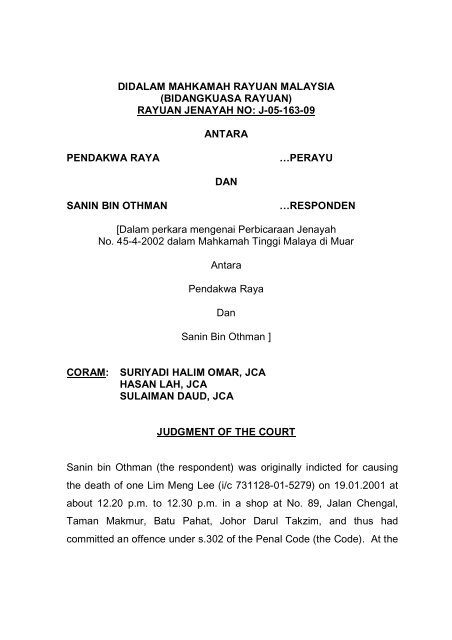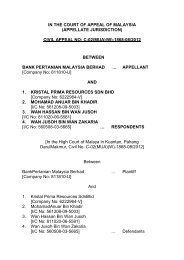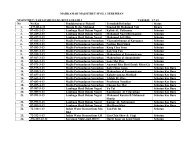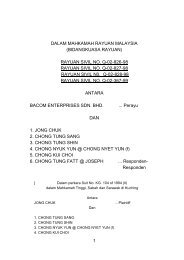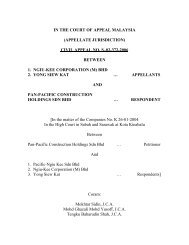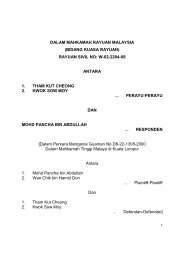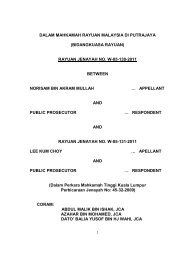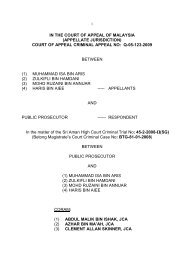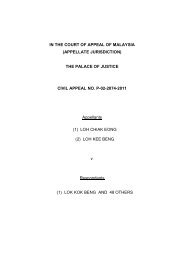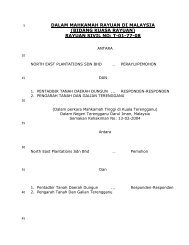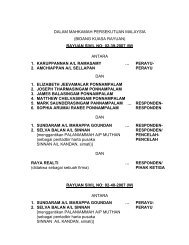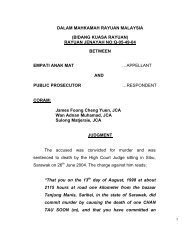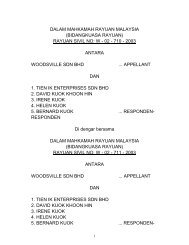rayuan jenayah no: j-05-163-09 antara pendakwa raya
rayuan jenayah no: j-05-163-09 antara pendakwa raya
rayuan jenayah no: j-05-163-09 antara pendakwa raya
You also want an ePaper? Increase the reach of your titles
YUMPU automatically turns print PDFs into web optimized ePapers that Google loves.
DIDALAM MAHKAMAH RAYUAN MALAYSIA<br />
(BIDANGKUASA RAYUAN)<br />
RAYUAN JENAYAH NO: J-<strong>05</strong>-<strong>163</strong>-<strong>09</strong><br />
ANTARA<br />
PENDAKWA RAYA …PERAYU<br />
DAN<br />
SANIN BIN OTHMAN …RESPONDEN<br />
[Dalam perkara mengenai Perbicaraan Jenayah<br />
No. 45-4-2002 dalam Mahkamah Tinggi Malaya di Muar<br />
Antara<br />
Pendakwa Raya<br />
Dan<br />
Sanin Bin Othman ]<br />
CORAM: SURIYADI HALIM OMAR, JCA<br />
HASAN LAH, JCA<br />
SULAIMAN DAUD, JCA<br />
JUDGMENT OF THE COURT<br />
Sanin bin Othman (the respondent) was originally indicted for causing<br />
the death of one Lim Meng Lee (i/c 731128-01-5279) on 19.01.2001 at<br />
about 12.20 p.m. to 12.30 p.m. in a shop at No. 89, Jalan Chengal,<br />
Taman Makmur, Batu Pahat, Johor Darul Takzim, and thus had<br />
committed an offence under s.302 of the Penal Code (the Code). At the
2<br />
close of the case for the prosecution, the respondent submitted that<br />
there was only a case to answer under s.304 but <strong>no</strong>t under s.302 of the<br />
Code. His intention was only to rob and <strong>no</strong>t to kill or to cause such<br />
bodily injury likely to cause death. Furthermore his demea<strong>no</strong>ur was<br />
inconsistent with the intention under s.300 of the Code.<br />
At the end of the case for the prosecution, the charge of murder was<br />
indeed amended to one of culpable homicide <strong>no</strong>t amounting to murder<br />
and punishable under the 1st limb of section 304 of the Code (the first<br />
trial). A charge of attempted robbery under s.393/397 of the Code was<br />
also added. The respondent pleaded guilty to both charges. He was<br />
convicted and sentenced to 12 years imprisonment for the amended<br />
charge and 6 years imprisonment and 6 strokes of the rotan for the<br />
additional charge. Both sentences were ordered to run concurrently.<br />
The prosecution appealed against the decision and the Court of Appeal<br />
(the COA) allowed the appeal on 19.1.20<strong>09</strong>. The COA ordered<br />
defence to be called under the original charge of s. 302 of the Code.<br />
When defence is directed to be called by an appeal court the trial judge<br />
must accept that a prima facie case has been proven. It is as if the<br />
defence was called by the learned judge himself (Saad Abas & A<strong>no</strong>r v<br />
PP [1998] 4 CLJ 575). Only after he has gauged the total evidence<br />
adduced, inclusive of all the evidence adduced at the prosecution’s<br />
stage, and tested as against the defence evidence may the fate of the<br />
accused person be decided by the court. In short there will be a<br />
maximum evaluation of the whole evidence at the close of the defence.
3<br />
In this appeal the same learned judge who heard the defence, after<br />
conducting the trial to fruition, found the respondent guilty of the lesser<br />
charge of s. 304(a) of the Code (the second trial). The Public<br />
Prosecutor filed an appeal and this court heard the appeal. We allowed<br />
the appeal and set aside the High Court order whereupon the<br />
respondent was found guilty of murder. We convicted him and<br />
accordingly sentenced him to death.<br />
The facts of the case, which are as follows, will explain why we found<br />
him guilty of the charge of murder. On 19.01.2001 PW14 and her<br />
husband i.e. the deceased were in their shop, registered as Perniagaan<br />
Eng Hong. At about 12.20 p.m. to 12.30 p.m. the respondent parked his<br />
motorcycle in front of the shop and entered it. He requested for fish<br />
nets and a small box to keep fishing hooks. PW14 placed the items on<br />
the L-shaped sales counter. The respondent then went behind the<br />
sales counter, looked at some fishing lines, and then walked to the back<br />
of the shop. He pointed to a room and asked whether that was the<br />
office and PW14 answered in the affirmative. The deceased was inside<br />
the office at that time. PW14 then asked the respondent if he wanted<br />
anything else and he replied, “tunggu sekejap” (wait for awhile) and then<br />
walked out of the shop. A few minutes later he re-entered the shop. He<br />
also replied, “tengok-tengok” (looking around) when PW14 again asked<br />
whether he wanted anything else. The respondent then went behind the<br />
sales counter to where PW14 was and requested a small reel of fishing<br />
line. While PW14 was bending down to take the requested item the<br />
respondent came from the rear and suddenly grabbed her mouth. She<br />
felt a knife on the right side of her neck and heard the respondent utter,
4<br />
“diam-diam rompak” (quiet, robbery). Startled, she kicked the chair<br />
beside her and fell. That <strong>no</strong>ise attracted the attention of the deceased<br />
who thereupon entered the shop to investigate. PW14, when in the<br />
course of standing up, saw the respondent stabbing the deceased twice.<br />
The respondent then ran out of the shop. Both the deceased, who was<br />
then bleeding profusely, and PW14 cried out for help. PW5 who had<br />
stopped his motorcycle at a traffic junction nearby heard a female voice<br />
shouting “rompak” (robbery). He saw the respondent running very fast<br />
across his path. PW8 who was also at the scene assisted PW5 to<br />
apprehend the respondent by giving chase on their motorcycles. The<br />
respondent ran to a lane behind a petrol station which was a cul-de-sac<br />
and was trapped. He squatted and remained silent. PW8 heard the<br />
respondent saying, “Allah apa yang telah aku lakukan” (Allah what have<br />
I done). He was then caught and handed over to PW9, a police officer,<br />
who admitted hearing the respondent say, “kenapa aku buat” (why did I<br />
do it).<br />
The deceased died on the way to hospital. The police found a bent<br />
knife (P31A) at the pavement (colloquially referred to as the ‘5 foot way’)<br />
and a<strong>no</strong>ther knife (P3OA) inside the shop. PW16 who conducted the<br />
post mortem found 2 stab wounds on the deceased. One stab wound<br />
measured 4.5cm x 2 cm, was located just left of the nipple and was<br />
14cm deep (nearly 6 inches), directed towards the back and right. The<br />
other stab wound was on the upper right back located below the neck<br />
and 5 cm to the right. That wound measured 5.5 cm x 1.5 cm and was<br />
13.5 cm deep, directed downwards. The doctor was quite graphic when
5<br />
he testified that the heart was cut, the right lung pierced, the liver was<br />
cut and the right diaphragm also cut. In <strong>no</strong> uncertain terms this witness<br />
said that either one of the stabbing was fatal.<br />
With the evidence being made available, whereas the wounds were<br />
caused by a sharp implement, and two knives being recovered on the<br />
scene, with one being bent and the other straight but covered with<br />
blood, there was <strong>no</strong> doubt that he had been stabbed with the latter. The<br />
knife covered with blood was P30 A, an implement that had all the<br />
features of an army knife (Rambo knife) and certainly menacing looking.<br />
As regards how the wounds could have been inflicted, PW16 testified<br />
that the rear wound would have been caused by ‘knife to body, rather<br />
than the other way round’. In a gist, even though it was possible for the<br />
front wound to have been inflicted by the deceased having lunged<br />
forward, by <strong>no</strong> account could that suggestion be applicable for the rear<br />
wound. PW14 put to rest all speculations when she denied that the<br />
deceased had lunged forward or even tripped. She clearly saw the<br />
respondent stabbing the deceased (hence discounting the suggestion<br />
that the stabbing occurred due to the body forcing itself onto the knife,<br />
inadvertently caused by the sheer momentum of the sudden lunging<br />
forward or tripping). She likewise denied that the rear injury was<br />
inflicted by a quirk when the deceased had attempted to stand upright.<br />
In short the wounds were never inflicted because of some accidental<br />
stabbing. She categorically stated that the deceased was never at any<br />
time armed as opposed to the respondent, who even though had lost
6<br />
the first knife (P31A), had rearmed himself with P30A i.e. the very knife<br />
used to stab the deceased twice.<br />
With a prima facie case having been made out, and the COA directing<br />
that the defence be called, it was then up to the respondent to adduce<br />
rebuttal evidence, an evidential burden that rested on him to raise a<br />
reasonable doubt (Balachandran v PP [20<strong>05</strong>] 1 CLJ 85). In his defence<br />
the main thrust of his testimony, inter alia reads as follows:<br />
“Saya nampak ada duit dalam mesin duit. Baru teringin<br />
makan, Nampak. Saya fikir perempuan seorang, baru saya<br />
pergi ke motor mengambil pisau.<br />
….<br />
Setelah mengambil pisau saya masuk balik ke dalam kedai<br />
pancing. Saya suruh wanita mengambil barang di bawah<br />
Almari. Semasa wanita bercangkung, saya menutup mulut<br />
wanita itu. Saya di tepi wanita, sebab tempat sempit. Pisau<br />
saya di leher wanita.”<br />
…<br />
Saya cuba lari, tetapi lelaki itu menuju kepada saya. Terjadi<br />
satu pergelutan kecil, sampai yang dia dapat pisau yang<br />
saya pegang. Dia cuba menikam saya.<br />
Saya bergelut lagi. Saya masuk tangan saya ke dalam<br />
almari, mencapai sesuatu, macam, waktu itu saya tak pasti.<br />
Saya tolak lelaki, saya cuba lari. Lelaki menghadap saya<br />
dengan belakangnya ke pintu besar. Saya lari, dan lelaki
7<br />
terus bangun. Dengan itu saya tertikam lelaki di bahagian<br />
belakang kanan. Lelaki pusing dan terus menerpa saya.<br />
Pisau itu terkena lagi. Saya terlampau takut, saya terus<br />
campak pisau yang saya pegang. Saya tak pegang pisau<br />
selepas tikaman pertama.”<br />
His other evidence went along the line that he was remorseful and did<br />
<strong>no</strong>t intend to kill the deceased.<br />
The learned judge when reducing the charge to that of s.304(a) of the<br />
Code had authored amongst others that the defence was sprung at the<br />
earliest of stages i.e. at the stage of the cross-examination of SP9. The<br />
respondent merely wanted to rob but in the course of his robbery<br />
attempt a struggle had ensued between the deceased and him at or<br />
about the sales counter. The injuries were accidentally inflicted during<br />
the struggle. The pool of blood at the sales counter fitted in with the<br />
defence that his getaway was barred when attempting to get out. On<br />
the facts, the initial intention of the respondent was never to kill but with<br />
matters spiraling out of control, he had grabbed P3OA from the sales<br />
counter and inflicted those injuries. The learned judge said there was a<br />
possibility that there was insufficient time for him to form the specific<br />
intention within the context of murder. That being so there was a<br />
lingering doubt on the intention that had been inferred in relation to<br />
murder.<br />
Specifically on the issue of intention the learned judge wrote:
8<br />
“At the close of the prosecution case, the court found that<br />
the accused had committed the act. The thorny issue was<br />
the intention which was inferred, but which the accused<br />
contested. But at the end of the entire case, could that<br />
intention still be steadfastly inferred? The accused denied<br />
he had the intention to cause death, and or had the intention<br />
to cause bodily injury sufficient in the ordinary course of<br />
nature to cause death. His explanation was that he was<br />
impeded as he attempted to flee, that a struggle ensued<br />
between him and the deceased, that he grabbed P30A from<br />
the sales counter, and that those 2 stab wounds were<br />
inflicted either accidentally during the struggles or were<br />
inflicted with the intention only to make his getaway but <strong>no</strong>t<br />
to kill. That was about the purport and net effect of the<br />
defence story”<br />
Since the Court of Appeal pursuant to the first trial had ordered defence<br />
to be called, it was <strong>no</strong>w incumbent upon the respondent to rebut the<br />
prosecution’s case, though subject to a maximum evaluation of the<br />
whole case by the learned judge. Since a maximum evaluation is<br />
mandated, let alone an appeal is merely a continuation of the trial and<br />
throws open all the evidence to re-examination, let us review the<br />
evidence adduced at the stage of the prosecution justifying the calling of<br />
the defence, to be followed by testing it against the rebuttal evidence if<br />
any (Muniandy a/l Subramaniam v Public Prosecutor [2006] 6 MLJ 623).
9<br />
But before any testing is done, since the respondent was charged for an<br />
offence under s.302 of the Penal Code, the prosecution must establish<br />
certain ingredients. The latter must establish the death of the deceased,<br />
the death was caused by the respondent, he intended to cause death or<br />
intended to cause bodily injury as the respondent k<strong>no</strong>ws to be likely to<br />
cause the death or if intended to cause bodily injury the injury intended<br />
to be inflicted is sufficient in the ordinary course of nature to cause<br />
death or the respondent knew that his act was so imminently dangerous<br />
and likely to cause death (s.300 of the Penal Code).<br />
At the stage of the prosecution it was established that:<br />
i. the respondent stabbed the deceased;<br />
ii. he was stabbed with a knife which is a deadly weapon as factually<br />
found by the learned judge. The deliberate use of a dangerous<br />
weapon leads to the irresistible inference of an intention to cause<br />
death (Sainal Abidin bin Mading v PP [1999] 4 MLJ 497; Tham Kai<br />
Yau & Ors v Public Prosecutor [1977] 1 MLJ 174);<br />
iii. the stabbings occurred at vital parts of the body. The Federal<br />
Court in Tan Buck Tee v Public Prosecutor [1961] 27 MLJ 176<br />
had occasion to state:<br />
“There was the body with the five appalling wounds<br />
on it, wounds penetrating to the heart and liver,<br />
which must, have been caused by violent blows<br />
with a heavy sharp instrument like an axe. In the<br />
absence of anything else, whoever inflicted those
10<br />
blows must have intended to kill the person on<br />
whom they were inflicted….(emphasis supplied)”;<br />
iv. the 2 stab wounds were deep (about 6 inches) indicating the<br />
application of great force and a desire to do great harm. None<br />
were lacerations or cuts <strong>no</strong>rmally associated with one flaying a<br />
knife around when attempting to escape;<br />
v. there were 2 stab wounds, either of which was sufficient to cause<br />
death. In Public Prosecutor v Tan Joo Cheng & Ors [1991] 1 MLJ<br />
196 while committing a robbery the appellant had stabbed the<br />
deceased once on the neck. Despite the singular stab wound<br />
inflicted he was nevertheless found guilty of murder. The<br />
emphasis in this case was <strong>no</strong>t the number of stabs but rather the<br />
intention to strike at a vital spot;<br />
vi. the deceased was never armed, and the issue of self defence on<br />
the part of the respondent, could never be raised;<br />
vii. even though he had lost the knife, which he took from his<br />
motorcycle, he had <strong>no</strong> compunction in grabbing a<strong>no</strong>ther one;<br />
viii. the grabbing of a<strong>no</strong>ther knife, if <strong>no</strong>t to pursue his criminal intention<br />
to rob, was certainly to assist him escape <strong>no</strong> matter the cost; and<br />
ix. he had every chance of escaping from the shop without the need<br />
to hurt anyone.<br />
Let us <strong>no</strong>w sift through some of the evidence adduced by the<br />
respondent at the defence stage especially the verbatim evidence<br />
supplied above. Testing it against the evidence adduced at the<br />
prosecution’s stage, these falsities were detected:
11<br />
i. the respondent stated that while struggling with the deceased the<br />
latter had managed to grab the knife from him. Yet SP 14 stated<br />
that the deceased never at any stage was in possession of any<br />
weapon. Even though she is an interested witness her evidence<br />
is entitled to credence until there is cogent evidence adduced for<br />
disbelief (Public Prosecutor v Foong Chee Cheong [1970] 1 MLJ<br />
97). With <strong>no</strong> negative evidence that could have led to the<br />
rejection of her evidence it was <strong>no</strong> surprise that the COA called<br />
the defence;<br />
ii. on a supposition that the knife was grabbed from the respondent<br />
in a close quarter fight, surely he would have suffered cuts or<br />
lacerations. Yet SP 17 who took swabs of the respondent found<br />
<strong>no</strong> cuts on him. If the deceased had managed to grab the knife<br />
from the respondent the body at the mortuary would have been<br />
the respondent instead of the deceased;<br />
iii. the sequence of the respondent’s narration was that he stabbed<br />
the deceased first from the rear. The improbability of this story is<br />
made obvious by his own admission that he ran first, followed by<br />
the deceased standing up. Surely had the respondent been in the<br />
process of running away, and the deceased left behind as<br />
admitted, it would have been impossible for the rear stab to have<br />
been inflicted in the way the respondent described.<br />
It must be highlighted that our approach when coming to the<br />
conclusion of the improbability of the respondent’s story had taken<br />
cognizance of the principles of Mat v Public Prosecutor [1963] 29<br />
MLJ 263. Had we believed the story of the respondent the appeal
12<br />
would have been dismissed at the outset. On the other hand<br />
there was <strong>no</strong> necessity for us to believe his story to earn an<br />
acquittal. All that was required of him was to raise a reasonable<br />
doubt (Mohamad Radhi bin Yaakob v Public Prosecutor [1991] 3<br />
MLJ 169);<br />
iv. then came the second stabbing. It was supposed to occur when<br />
the deceased turned around i.e. after the stab from the rear. Yet<br />
in <strong>no</strong> uncertain term, the respondent said that after the first<br />
stabbing i.e. the rear wound, he never stabbed again (Saya tak<br />
pegang pisau selepas tikaman pertama). If he had released the<br />
knife how then did the second stabbing materialize; and<br />
v. the respondent, had behaved unreasonably as in the<br />
circumstances of the case he must surely k<strong>no</strong>w that the first stab<br />
wound, let alone followed by a<strong>no</strong>ther fatal wound, would kill the<br />
deceased (Mohamed Ali v Public Prosecutor (infra). It must be<br />
clarified that it is unnecessary for us to conduct an enquiry to show<br />
that the respondent intended the precise injuries caused by his<br />
knifing of the deceased or he had medical k<strong>no</strong>wledge of the<br />
anatomy of the deceased and that the stabbings would cut or<br />
pierce the heart, lung, liver and the diaphragm. If such a demand<br />
were put on the DPP to establish anatomical k<strong>no</strong>wledge first<br />
before successfully establishing intention only doctors would be<br />
convicted for murder. What is required from a trial judge is a<br />
broad based and common-sense enquiry (Virsa Singh v State of<br />
Punjab AIR 1958 SC 465; Mohamed Yasin bin Hussin v Public<br />
Prosecutor [1976] 1 MLJ 156).
13<br />
The illustrated issues, amongst others, merely go toward establishing<br />
the need to sieve the evidence of the respondent with care and <strong>no</strong>t to<br />
accept it at its face value, bearing in mind some falsity has been<br />
detected in his evidence. Once his veracity has been shown to be<br />
doubtful the whole of his evidence must be scrutinized with care. But it<br />
must be stressed that the doctrine of ‘false in one thing false in<br />
everything’ has to be taken with a pinch of salt as it merely involves the<br />
question of weight to be given to the evidence adduced in a given<br />
circumstance. It does <strong>no</strong>t mean that his whole testimony must be<br />
rejected outright. His evidence must be appraised hence the need to<br />
separate the grain from the chaff e.g. the fact that the respondent took<br />
P30A from the sales counter and stabbed the deceased are admissions,<br />
and thus admissible evidence, but <strong>no</strong>t the exculpatory parts (Mohamed<br />
Ali v Public Prosecutor [1962] 28 MLJ 230; Sucha Singh v State of<br />
Punjab (2003) Cri. L.J 3876).<br />
Since it is <strong>no</strong> easy task to establish the ingredient of intention it thus has<br />
to be established by inferences arrived at from the evidence made<br />
available. The evidence before the court was more than ample to<br />
establish that ingredient. To reiterate, the two injuries were caused by a<br />
dangerous instrument i.e. a knife. The injuries were deep and never<br />
mere slash wounds. With such wounds, which must have required<br />
great force, it would defy logic that the respondent did <strong>no</strong>t intend to kill<br />
or cause serious injury on the deceased (Tan Buck Tee v Public<br />
Prosecutor (supra).
14<br />
It could never be overly emphasized that intention can be formulated on<br />
the spot. The time span spent in the shop, from the time he placed the<br />
knife next to the neck of PW14, to the moment when the deceased<br />
appeared on the scene were <strong>no</strong>t mere seconds. There was more than<br />
ample time for the respondent to formulate his intention to kill, or cause<br />
injury to someone, and that injury was sufficient in the ordinary course of<br />
nature to cause death in the event anyone gets in his way.<br />
Ratanlal & Dhirajlal’s Law of Crimes, 24 th. Ed. Vol 11, Bharat Law<br />
House, New Delhi had authored:<br />
“….If from the intentional act of injury committed the<br />
probability of death resulting is high, the findings should be<br />
that the accused intended to cause death or injury sufficient<br />
in the ordinary course of nature to cause death and the<br />
conviction should be murder.”<br />
In Rajwant Singh v State of Kerala AIR (53) 1966 SC 1974 at 1978 the<br />
court held:<br />
“As was laid down in Virsa Singh v State of Punjab…. For<br />
the application of this clause it must be first established that<br />
an injury is caused, next it must be established objectively<br />
what the nature of that injury in the ordinary course of nature<br />
is. If the injury is found to be sufficient to cause death one<br />
test is satisfied. Then it must be proved that there was an<br />
intention to inflict that very injury and <strong>no</strong>t some other injury
15<br />
and that it was <strong>no</strong>t accidental or unintentional. If this is also<br />
held against the offender the offence of murder is<br />
established (emphasis supplied).”<br />
A case in point is Tan Cheow Bock v Public Prosecutor [1991] 3 MLJ<br />
404, where in the course of committing a robbery death was inflicted on<br />
the victim, culminating in the court finding the accused person<br />
(appellant) guilty of murder. The deceased was a housewife living<br />
together with other occupants whilst the appellant was a neighbor. One<br />
of the occupants of the house later found the deceased dead with a<br />
knife stuck in her mouth. The appellant admitted in evidence that he<br />
went to the deceased’s house to commit robbery, but due to matters<br />
getting out of hand, thrust the knife into the deceased’s mouth thus<br />
causing her death. The court opined that so long as the appellant did<br />
an act which caused the death of the deceased, that the said act was<br />
done with the intention of causing bodily injury, that the injury caused<br />
was <strong>no</strong>t accidental or otherwise unintentional and was sufficient in the<br />
ordinary course of nature to cause death, <strong>no</strong> further requirement was<br />
demanded. With the above ingredients established, and the trial judge<br />
having found the injury was caused intentionally as opposed to an<br />
accident, the conviction of murder was affirmed. In a gist even though<br />
the episode began as a robbery, but ended as a murder case, so long<br />
as the requirements of s. 300(c) of the Code are complied with, a<br />
conviction for an offence of s. 302 of the Code will follow (see also<br />
Public Prosecutor v Tan Joo Cheng & Ors [1991] 1 MLJ 196; Public<br />
Prosecutor v Neoh Bean Chye & A<strong>no</strong>r [1975] 1 MLJ 3).
16<br />
The last two matters to be resolved are his weak disposition/personality<br />
and the issue of the deceased preventing the respondent from escaping<br />
the scene of the crime which culminated in his death. On the first<br />
matter, to say that the respondent was of weak disposition (as he<br />
testified that he was frightened when the deceased appeared hence his<br />
reaction) and unable to control his emotion would fly against the grain of<br />
evidence. The fact that the respondent asked certain questions<br />
followed by good evasive answers when probed by PW14, striding out<br />
of the shop to pick up a knife from his motorbike after his mind to rob<br />
was made up, followed by him springing into action, merely goes to<br />
show his controlled disposition. On the second matter, in the<br />
circumstances of the case it is an absurd defence to allege that the stoic<br />
deceased was to be defaulted for impeding the escape route, with <strong>no</strong><br />
fault to be assumed by the respondent by the death. To agree to such a<br />
defence would tantamount to accrediting a murderer an escape-chute<br />
whenever death ensues in any given situation.<br />
We were satisfied beyond reasonable doubt that the respondent had the<br />
intention to cause bodily injury to the deceased, and the bodily injury<br />
intended to be inflicted was sufficient in the ordinary course of nature to<br />
cause death, what with the injury <strong>no</strong>t caused by accident or inflicted<br />
unintentionally (s.300(c) of the Code). PW16 in evidence had in<br />
crystalline terms testified that those wounds could <strong>no</strong>t have been<br />
accidentally caused (Chee Kim Seng & A<strong>no</strong>r v Public Prosecutor [1962]<br />
28 MLJ 32). PW14’s evidence also put to rest any lingering doubt as to<br />
whether the stabbings were accidental, unintentional or otherwise.
17<br />
The fact that the episode began as a robbery attempt but ended with the<br />
death of the deceased was of <strong>no</strong> defence to the murder charge<br />
proffered against the respondent. So long as the criminal act falls within<br />
the ambit of s.302 with the intention falling under s.300 of the Code, in<br />
this case s.300 (c), the fate of the respondent was sealed. We were<br />
satisfied that the evidence submitted by him had failed to rebut the<br />
prosecution’s case and as such the prosecution had successfully<br />
established a case beyond reasonable doubt for the charge of murder.<br />
It was based on these grounds that this Court allowed the appeal and<br />
set aside the order of the High Court. We accordingly found him guilty<br />
and convicted him under the original charge of murder. With there<br />
being only one sentence for murder we sentenced him to death.<br />
Dated this 26 th day of October 2010<br />
SURIYADI HALIM OMAR<br />
Judge<br />
Court of Appeal, Malaysia<br />
Counsel for the appellant : Awang Armadajaya bin Awang<br />
Mahmud<br />
Solicitors for the appellant : Jabatan Peguam Negara<br />
Counsel for the respondent : K.Sandrasegaran<br />
Solicitors for the respondent : Messrs Tay, Bernard & Cheong


